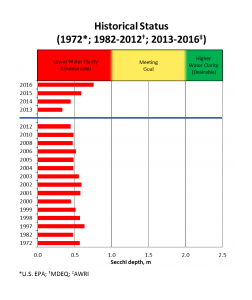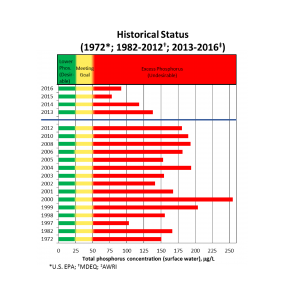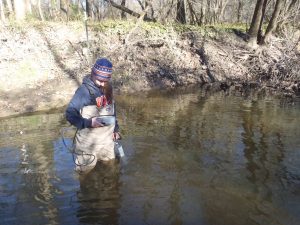LIVING SUSTAINABLY: Working on Lake Mac’s Reputation
By Dan Callam, Macatawa Greenway Manager
Just how healthy – or unhealthy – is Lake Macatawa? Does it deserve its murky reputation?
Grand Valley State University’s Annis Water Resources Institute has produced its annual monitoring dashboard for Lake Macatawa. The report summarizes sampling on Lake Macatawa during 2016. The Institute’s monitoring supports Project Clarity, the local effort led by the Outdoor Discovery Center Macatawa Greenway to clean and restore the Macatawa watershed.
Results from 2016 sampling show some improvement in water clarity and a slight  increase in phosphorus in Lake Macatawa. Long-term impact is hard to gauge until decades of data is in, but recent years’ results show some improvement in clarity the past four years and a slight downward trend in phosphorous. Some natural variability occurs depending on weather and other conditions. But both indicators are still at undesirable levels for a healthy lake.
increase in phosphorus in Lake Macatawa. Long-term impact is hard to gauge until decades of data is in, but recent years’ results show some improvement in clarity the past four years and a slight downward trend in phosphorous. Some natural variability occurs depending on weather and other conditions. But both indicators are still at undesirable levels for a healthy lake.
Lake Macatawa is considered to be a hypereutrophic lake, meaning that it has extremely high levels of nutrients and sediment. Sediment and the nutrient phosphorus can result in murky waters, poor habitat and detrimental algae blooms. Development in the greater Holland area has increased storm water volume, which leads to increased erosion. Ultimately, this results in increased amounts of pollutants reaching Lake Macatawa.
Supported by more than $10 million in funding, Project Clarity has been working to treat sources of sediment and nutrients, thereby reducing the amount of pollutants reaching Lake Macatawa.
The work includes constructing and restoring large wetland complexes to detain floodwater and remove pollutants. This replaces some of the wetlands lost to settlement and development. To date, 58 water quality projects have been completed with local farmers, governments and businesses. These projects will increase water storage on those sites and keep phosphorus out of waterways. Projects have been completed and improved practices are either implemented or pledged for nearly 11,000 acres.
 With a great deal of variability from year to year in lake systems, continued monitoring is needed to see long-term changes and track the overall progress of Project Clarity.
With a great deal of variability from year to year in lake systems, continued monitoring is needed to see long-term changes and track the overall progress of Project Clarity.
“It allows us to differentiate trends that are associated with the restoration activities from those that are part of any ecosystem’s natural variation,” said Al Steinman, director of the Annis Water Resources Institute.
“Some years are dry and some are wet; some years are cold and some are warm. That kind of background variation can mask trends associated with real progress, so we need long-term monitoring to get a robust sense of whether the trends we are seeing are due to natural variation or to restoration activities.”
This past year demonstrated periods of amazing clarity on Lake Macatawa, as well as late-season algae blooms and murky waters following rain or snowmelt. While the early data is encouraging, the community needs to adopt additional practices that hold storm water and keep nutrients out of waterways.
Farm field and infrastructure projects completed to date are great examples, but until those are commonplace, the Macatawa Watershed will continue to struggle with water quality issues.
The Annis Institute also collects other data on Lake Macatawa and several of its tributaries, on conditions around restoration projects, and on fish populations in the lake. To learn more, the entire Lake Macatawa Dashboard report, as well as the full Project Clarity Monitoring Report, can be found on the Project Clarity website: macatawaclarity.org/monitoring.
Images:
((2016 Clarity chart cutline)): Most recent test results show a trend of improving clarity in Lake Macatawa.
((2016 Phospherous chart cutline)): Test results show a slight increase in phosphorous in 2016 but hopeful signs of decreasing levels long-term.
((Baseflow.jpg – Annis Water Resources Institute graduate student Emily Kindervater measures water quality in the Macatawa River for Project Clarity. (Courtesy photo – GVSU-AWRI staff)
-Dan Callam is Greenway Manager for the Outdoor Discovery Center Macatawa Greenway
![]() This Week’s Sustainability Framework Theme
This Week’s Sustainability Framework Theme
Environmental Awareness/Action: Environmental education and integrating environmental practices into our planning will change negative outcomes of the past and improve our future.
ABOUT THIS SERIES
Living Sustainably is a collection of community voices sharing updates about local sustainability initiatives. It is presented by the Holland-Hope College Sustainability Institute, a joint project of Hope College, the City of Holland, and Holland Board of Public Works. Go to www.hope.edu/sustainability-institute for more information.


